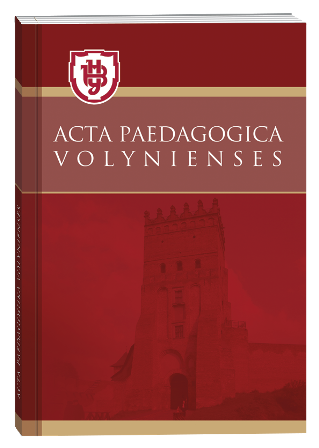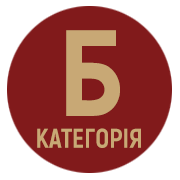THE LINGUISTIC COMPLEXITY OF EDUCATIONAL TEXTS IN READING TEXTBOOKS FOR YOUNGER SCHOOL STUDENTS
DOI:
https://doi.org/10.32782/apv/2024.2.5Keywords:
reading textbooks, linguistic complexity of the text, difficulty parameters, younger studentsAbstract
The article examines the linguistic complexity of artistic and informational texts of actual (2020–2021) reading textbooks for 3rd – 4th grades. The importance and necessity of assessing the complexity of educational texts in the age period when the formation of full-fledged reading skills of students is still ongoing, and there is functional immaturity of individual cognitive processes of children, mechanisms of visual perception, insufficient level of vocabulary, background knowledge, etc., are substantiated. In order to achieve the research aim, the main parameters of the linguistic complexity of texts in the aspect of text generation were characterized in the research process: length of sentences; syntactic complexity of sentences; word length; separate parameters of the lexical structure of the texts (abstractness of the vocabulary; the presence of complex lexemes with the coincidence of three, and sometimes even 4 consonants, etc.). Based on the conclusions of the majority of domestic and foreign scientists, the optimal quantitative and qualitative indicators for primary school students were determined. The subject of a detailed study was the meaningfully complete excerpts from artistic (fairy tales, stories, myths) and informational texts (24 excerpts in total), which were analyzed according to the defined parameters of linguistic complexity. Based on the results of the research, quantitative characteristics were obtained in numerical and percentage values of each passage separately (listed in Tables 1–4). Quantitative-qualitative analysis of the obtained data proved the noncompliance of most of the texts with the optimal complexity parameters. They exceeded the permissible values within all analyzed readability parameters. Consequently, they will cause difficulties in most students during reading/comprehension, will increase the intellectual and sensory load of schoolchildren's educational activities. This actualizes the increased attention of editors of publishing houses, writers, compilers of textbooks to the evaluation of the complexity of texts during the preparation for the printing of publications for children.
References
Вернигора Н. До проблеми дискурсу текстів для дитячого сприйняття// Наукові записки Інституту журналістики. 2014. – Т. 55. С. 116–119.
Гривко А. Автоматизований текстовий аналіз підручника // Проблеми сучасного підручника. 2015. Вип. 15(1). С. 147–158.
Звіт про результати другого циклу загальнодержавного зовнішнього моніторингу якості початкової освіти «Стан сформованості читацької та математичної компетентностей випускників початкової школи закладів загальної середньої освіти» 2021 р. Частина І. Що знають і вміють випускники початкової школи та як змінилася ситуація за три роки /Український центр оцінювання якості освіти. Київ, 2022. 189 с.
Кодлюк Я., Одинцова Г. Формування у молодших школярів усвідомленого читання засобами навчальних текстів підручника // Слово. Стратегії. Інновації: колективна монографія. – Тернопіль : Осадца Ю. В., 2022. С. 6–62.
Кузьмич А. Проблема довжини речень у мовознавстві, // Наукові записки [Національного університету "Острозька академія"]. Серія : Філологічна. – 2012. – Вип. 31. – С. 42–44.
Мартиненко В. Індивідуальний підхід до формування навички читання у молодших школярів. Методичний посібник. Київ: Конві Прінт. 2020. 88 с.
Прихода Я. Мовна культура в підручниках. Київський національний університет імені Тараса Шевченка, Київ, 2021.
Про затвердження Державних санітарних норм і правил «Гігієнічні вимоги до друкованої продукції для дітей» : наказ Міністерства охорони здоров’я України від 18.01.2007 р. № 13 [165]. [Електронний ресурс] / Інтернет-видання «Баланс-клуб». – Режим доступу: http://www.balance.ua/ua/news/detail/6163/
Савченко О. Методичний потенціал нового підручника з літературного читання у 3-му класі. Проблеми сучасного підручника. К. Наукова думка. 2020. С. 133–148.
Селігей П. Український науковий текст: проблеми комунікативної повноцінності та стильової досконалості: дис. на здобуття наук. ступеня доктора філолог. наук. К. 2016. 427 с.
Через складність багатьох підручників НУШ учні можуть засвоїти їх лише на 30% Веб-ресурс НУШ. URL: https://nus.org.ua. 6 Січня 2021 р.
Якими мають бути тексти в підручниках, аби учні їх легко сприймали й розуміли : Веб-ресурс НУШ. URL: https://nus.org.ua. 21 Грудня 2021 р.
Spichtig, A. et al. The Decline of Comprehension-Based Silent Reading Efficiency in the United States: A Comparison of Current Data with Performance in 1960/ Reading Research Quarterly, 2016. Vol. 51. № 2. pp. 239–259.
Werpup-Stüwe L., Petermann F. Visual perception abilities in children with reading disabilities // Kinder Jugendpsychiatr Psychother. 2015. May; 43(3), pp. 195–205.
Huestegge, L., et al. Oculomotor and linguistic determinants of reading development: A longitudinal study / Huestegge //Vision Research. – 2009. – V. 49. – pp. 2948–2959.







